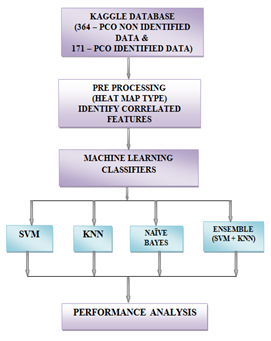Detection of Polycystic Syndrome in Ovary Using Machine Learning Algorithm
Keywords:
PCOS, SVM, KNN, Naïve Bayes, Ensemble, Evaluation MetricsAbstract
PCOS is the reproductive metabolic condition in which the ovary produces the number of follicles that is unusually high. The number of follicles, size, and location of the ovary are observed using the data set of the ovary. Because of the varied sizes of follicles and the fact that it is strongly linked to veins and tissues, radiologists have traditionally had a tough time diagnosing PCOS. To predict the PCO syndrome fertility and infertility for the data collected the from KAGGLE repository, preprocessing techniques are being used to extract useful information for analysis. Heat Map is the preprocessing technique used for identifying correlated features. Then the extracted data are considered for training and testing to classify the occurrence and nonappearance of PCO syndrome. For data training and classification, Support Vector Machine, KNN, Naive Bayes, and Hybrid Algorithm are used. The proposed approach outperforms other current methods and has been proven to be effective.
Downloads
References
A. Pellicer, P. Gaitán, F. Neuspiller, G. Ardiles, C. Albert, J. Remohíand C. Simón, “Ovarian Follicular Dynamics: From Basic Science to Clinical Practice”, Journal of Reproductive Immunology, Vol. 39, No. 12, Pp.29-61,2021.
Affiliates of Medifocus.com, “Medifocus Guidebook: Polycystic OvarySyndrome”, Medifocus.com, Inc, 2007.
T.W. Kelsey and Wallace W.H.B. “Ovarian Volume Correlates Strongly with Number of Non-Growing Follicles in the Human Ovary”, Obstetrics and Gynecology International, Vol. 2012, Pp. 1-5, 2012.
C. Battaglia, P.G. Artini, A.D. Genazzani, R. Gremigni, M.R.Slavatoriand M.R. Sgherzi, “Color Doppler Analysis in Oligo and Amenorrheic Women with Polycystic Ovary Syndrome”, GynecologicalEndocrinology, Vol. 11, No. 2, Pp. 105-110, 2020.
Theresa Prince. R, J. Thomas,” Human Heart Disease, Prediction System using Data Mining Techniques, Vol. 12, No. 3, Pp. 100-105 2016.
M.C. Nicolae, “Comparative Approach for Speckle Reduction in medical Ultrasound Images”, Romanian Journal of Bio-Physics, Vol.20, No. 1, Pp. 13-21, 2010.
Yao Xiao, Ruogu Fang,” RFMiner: Risk Factors Discovery and Mining for Preventive Cardiovascular Health”, IEEE/ACM, (CHASE), Pp- 278-279, 2017
Messan Komi, Jun Li, Y Yongxin Zhai, Xianguo Zhang,” Application of Data Mining Methods in Diabetes Prediction”, 2nd International Conference on Image, Vision, and Computing. Vol. 53, no. 1, Pp. 64-78, 2017.
Y. Deng, Y. Wang, and P. Chen, “Automated Detection of PolycysticOvary Syndrome from Ultrasound Image”, 30th Annual International IEEE Engineering in Medicine and Biology Society ConferenceVancouver, British Columbia, Canada, pp. 20-24, 2008.
P.S. Hiremath and Jyothi R. Tegnoor, “Automatic Detection of Follicles in Ultrasound Images of Ovaries using Edge Based Method”, International Journal of Computer Applications Special Issue on RecentTrends in Image Processing and Pattern Recognition Pp. 15-16, 2010.
Y. Deng, Y. Wang, and Y. Shen, “An Automated Diagnostic System polycystic Ovary Syndrome based on Object Growing”, Journal of
Artificial Intelligence in Medicine, Elsevier Science Publishers Ltd.Essex, UK, Vol. 51, No. 3, Pp. 199-209, 2011.
P. Mehrotra and C. Chakraborty, “Automated Ovarian FollicleRecognition for Polycystic Ovary Syndrome”, International Conference on Image Information Processing, pp. 1-4, 2011.
P.S. Hiremath and R. JyothiTegnoor, “Automatic Detection of Follicles in Ultrasound Images of Ovaries using Active Contours Method,” International Journal of Service Computing and Computational Intelligence Vol. 1, No. 1, Pp. 26-30, 2011.
M. Alotaibi, A. Alsinan.” Mobile Polycystic Ovarian Syndrome Management and Awareness System for GulfCountries “, IEEE, SAI Computing Conference, Vol. 1, No. 1, Pp. 26-30, 1315,2016.
Sandy RIHANA, Hares Moussallem, Chiraz Skaf, Charles Yaacoub,” Automated Algorithm for Ovarian Cysts Detection in Ultrasonogram”, IEEE, 2nd International Conference on Advances in Biomedical Engineering, 2013.
S. Rethinavalli, Dr. M. Manimekalai,” A Hypothesis Analysis on the Proposed Methodology for Prediction of Polycystic Ovarian Syndrome”, S., November 2016 | Vol 6, Issue 11, Pp396-400
Uma Ojha, Dr. Savita Goel,” A study on prediction of Breast cancer Recurrence using Data mining techniques”, 7th International Conference on Cloud Computing, Data Science & Engineering – Confluence, Pp-527-530, 2017.
M. Iyapparaja, P. Sivakumar, “Metrics Based Evaluation for DiseaseAffection in Distinct Cities”, Research J. Pharm. and Tech., Vol. 10, No.8, pp. 2487-2491, 2017.
D. Selvathi, N.B. Prakash, V. Gomathi, G.R. Hemalakshmi, “Fundus image classification using wavelet-based features in detection of Glaucoma”, Biomed. Pharmacol. J. pp. 795–805. 2018
D.C. Shubhangi, N. Parveen, “A dynamic ROI based Glaucoma detection and region estimation technique”, Int. J. Computer Sci. Mobile Comput. pp. 82–86. 2019.
A Manjunathan, ED Kanmani Ruby, W Edwin Santhkumar, A Vanathi, P Jenopaul, S Kannadhasan, “Wireless HART stack using multiprocessor technique with laxity algorithm”, Bulletin of Electrical Engineering and Informatics, 10, 6, 3297-3302 (2021)
C Jeyalakshmi, A Manjunathan, A Karthikram, T Dineshkumar, W Edwin Santhkumar, S Kannadhasan, “Automatic Wireless Health Instructor for Schools and Colleges”, Bulletin of Electrical Engineering and Informatics, 11, 1 (2022)
S Karthikeyani, C Ganesh Babu, M Ramkumar, R Sarath Kumar, G Priyanka, A Manjunathan, “Determination of Cardiac Output based on Minimally Invasive Impedance Plethysmography in Various Healthy Subjects”, Int. J. Aquat. Sci, 12, 2021, 1078-1086

Downloads
Published
How to Cite
Issue
Section
License

This work is licensed under a Creative Commons Attribution-ShareAlike 4.0 International License.
All papers should be submitted electronically. All submitted manuscripts must be original work that is not under submission at another journal or under consideration for publication in another form, such as a monograph or chapter of a book. Authors of submitted papers are obligated not to submit their paper for publication elsewhere until an editorial decision is rendered on their submission. Further, authors of accepted papers are prohibited from publishing the results in other publications that appear before the paper is published in the Journal unless they receive approval for doing so from the Editor-In-Chief.
IJISAE open access articles are licensed under a Creative Commons Attribution-ShareAlike 4.0 International License. This license lets the audience to give appropriate credit, provide a link to the license, and indicate if changes were made and if they remix, transform, or build upon the material, they must distribute contributions under the same license as the original.





